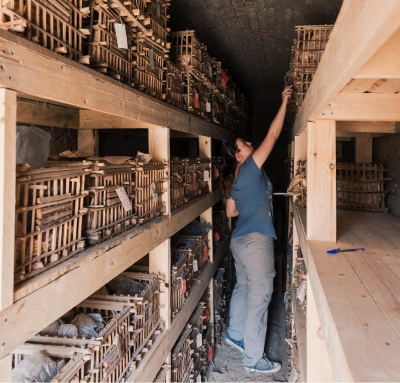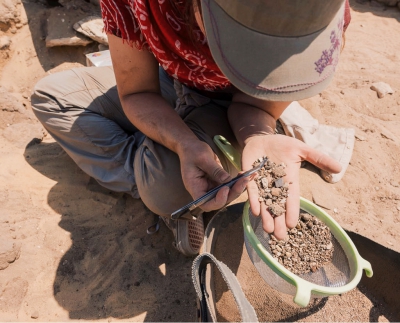“Only three working days in the field next week are left of our excavation season in Saqqara. As usual, the most exciting finds come up at the end, now in fact right on time to please our former field director (and RMO curator) Maarten Raven, who visited us for a few days this week. We have now reached the bottom of the Ramesside layer and found a few decorated blocks from the north wall of the larger of the two Ramesside chapels uncovered in 2017. Again, unfortunately, no name has been preserved. Also the third, new chapel was freed from the sand and now shows, for example, a beautiful burial procession scene with many vivid colours still preserved. Yet again the chapel owner remains anonymous. Perhaps we will find a name when we will excavate the related shaft in 2019. Finally, beside recording and documentation, we have now also started to clean and restore the reliefs and architectural elements with the help of our Egyptian colleagues.”
Lara Weiss

Artist Alice Salvador drawing objects in the tomb of Horemheb.

Our Egyptian colleagues restoring the larger Ramesside chapel north of the tomb of Maya.
“Loose Bone Material” (by Ali Jelene Scheers, Bone specialist)
Since arriving in Saqqara two weeks ago, I’ve been working on the bone material: new finds as well as bones found in previous seasons. When I arrived the new storage space in the tomb of Maya had just been finished. The bones found during the excavations of the tombs of both Maya and ‘Pay & Raia’ had been stored here in wooden crates since they were last studied. These crates were labeled by the previous excavators, but the storage situation was not ideal. Stacked five high on top of each other, the wooden crates had started to deteriorate considerably since the late ’80s and ’90s. A carpenter has now built wooden shelves, which greatly improves the accessibility of the crates (especially if you need a crate from the very bottom!) and creates a safer work environment (no more collapsing crates). When I arrived, all crates were put out into the forecourt of the tomb of Maya to make space for the construction works inside the storage room. I spent the first few days in the field figuring out what was in the crates, making an inventory, and then placing the bone material orderly into the ‘new’ storage room. From next year onwards, the bone material will be placed in plastic boxes as a next step of improvement, in terms of both storage and accessibility of the material for future research.

Ali sorting the crates in the new storage shelves.
After the storage room was completed, I focused on the loose bone material that was found this year. ‘Loose bone material’ includes all bones found during the excavations without any relation to other bones, i.e. bones that were not found in situwith a skeleton. When robbers entered a tomb to look for valuables, the skeletal material itself was not important to them. This material then often ended up scattered around the tomb shafts. As time moves on, the elements and animals in the area caused the bones to scatter farther and farther from the shaft they originally belonged to, until we excavate them. Of course, we don’t know where the bones have moved over time, so when excavating loose bones it is usually impossible to reassemble them to reconstruct skeletons. Therefore this material is quite challenging to interpret. What I do, is to record in detail what bone has been found where, and then use this information to make an educated guess about what we have found.

Excavating one of the child burials. As there are many small bone parts which could get lost, the sand around the burial was carefully sieved.
For example, if we found two left legs, two right legs, one right arm and three skulls in a certain context, I can say that at least three individuals are represented here: the left and right legs might belong to two individuals, but they might also belong to four separate individuals. The skulls provide me the clearest indication: at least three individuals were represented, as an individual with three heads is slightly unlikely.
As we’re digging deeper in the north area, the amount of scattered bones and bone fragments appearing from the sand becomes smaller. Last year, when we were much higher up, I processed around 1600 loose bones. This year, I’ve only processed around 300, leaving me much more time to focus on other things – such as the nice burials we found. Three of the four burials we found belonged to subadult individuals: a cursory examination of the remains indicates that one belongs to a neonate and one to a child between two and three years of age. These two burials were each wrapped in a cloth, which I have painstakingly removed from the remains of the little skeletons. The removal is hindered by the fact that some of the cloth falls apart as soon as you touch it, and the other part is clumped together in an impenetrable mass. So I’ve been slowly wetting part of the textile, in order to carefully lift it with my tweezers. Add in the fact that the bones themselves are lying quite loose in the material, that is a situation where you barely dare to breathe when working in hot weather conditions. Once a burial is fully excavated, it is ready for further analysis. Since we have only three working days left, this will probably be a job for next year. Hopefully I’ll be able to update you on my findings then!

Excavating the sole adult burial of this season. In order not to disturb the contexts around the burial, we sometimes have to take on uncomfortable positions!
